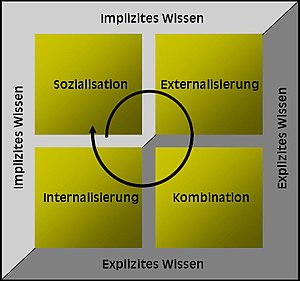SECI model
The SECI model ( S ocialization, E xternalization, C ombination, I nternalization) is a by the Japanese Ikujiro Nonaka and Hirotaka Takeuchi imagined model to model of knowledge creation, which as a basis of the knowledge management system is used. The model was first presented in 1995 in their book " The Knowledge Creating Company " (German 1997 as " The Organization of Knowledge "), which exerted a great influence on the following literature and research on the subject of knowledge management and is now one of the classics of this relatively young one Discipline can be viewed.
Building on the concept of tacit knowledge introduced by Michael Polanyi in 1966 , Nonaka and Takeuchi design a model in which knowledge is generated in a continuous transformation between implicit and explicit knowledge . Through successive processes of "externalization" (implicit to explicit), "combination" (explicit to explicit), "internalization" (explicit to implicit) and "socialization" (implicit to implicit), knowledge within an organization is spiraling up from individual knowledge higher organizational levels such as groups of people and entire companies. Knowledge is understood as a two-dimensional phenomenon, which in principle can only be generated by individuals, but which can be expanded and made usable within the framework of the SECI model.
Socialization : Knowledge is acquired in company cooperation and is implicitly available.
Externalization : Knowledge that is implicitly available is recorded, documented and thus transferred to explicit knowledge (reports, ...).
Combination: The explicit knowledge newly created through externalization is combined with other explicit knowledge e.g. B. through discussions.
Internalization (Latin: internalize): New knowledge is internalized. It is available as tacit knowledge and can be passed on to others through socialization.
literature
- Ikujirō Nonaka , Hirotaka Takeuchi : The organization of knowledge. How Japanese companies harness an idle resource. Translated from the English by Friedrich Mader. Campus-Verlag, Frankfurt am Main u. a. 1997, ISBN 978-3-593-35643-3 .
- Ikujiro Nonaka, Ryoko Toyama, Noboru Konno: SECI, Ba and Leadership: A Unified Model Of Dynamic Knowledge-Creation. In: Long Range Planning. Vol. 33, No. 1, 2000, pp. 5-34, doi : 10.1016 / S0024-6301 (99) 00115-6 .
- Michael Polanyi : Personal Knowledge. Towards a post-critical philosophy. The University of Chicago Press, Chicago IL 1958.
- Michael Polanyi: Implicit knowledge (= Suhrkamp-Taschenbuch Wissenschaft. 543). Suhrkamp, Frankfurt am Main 1985, ISBN 3-518-28143-7 .
- Günther Schanz : Implicit knowledge. Phenomenon and success factor, neurobiological and sociocultural basics, possibilities of problem-conscious design. Rainer Hampp, Munich 2006, ISBN 3-86618-007-1 .
- Markus Schönemann: Management of knowledge and skills. A contribution to the realignment of knowledge management. VDM-Verlag Müller, Saarbrücken 2008, ISBN 978-3-639-03181-2 .
- Georg Schreyögg , Daniel Geiger: If everything is knowledge, in the end knowledge is nothing ?! In: Business Administration. Vol. 63, No. 1, 2003, ISSN 0342-7064 , pp. 7-22, ( digital version (PDF; 235 KB) ).

